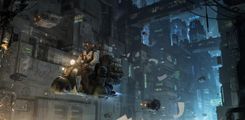Table of Contents
- What Are Video Game Art Styles?
- Common Art Styles in Games
- 2D Game Art Styles
- 3D Game Art Styles
- How to Choose the Right Art Style
- Final Thoughts
What Art Style Should I Use for My Video Game? Everything You Need to Know in 2024
Selecting the right art style is an important decision in game development. It shapes the player's experience and the overall aesthetic appeal. This guide will help you navigate the most common game art styles and choose the one that best fits your game.
When creating a video game, one of the most crucial steps a game designer takes early on is choosing the art style. It can be a personal choice or one influenced by budget and resource constraints, but your game's visual style not only determines its aesthetic appeal but also how players experience the world you’ve created.
With so many different game art styles in the industry, it can feel daunting to choose the right one, so how do you decide which is best for you?
In this guide, we’ll explore the most common video game art styles, how they impact gameplay and player experience, and how to choose the best style for your game and budget.
What Are Video Game Art Styles?
Video game art styles refer to the visual design of the game and they apply to everything from character designs and environments to UI design - in other words, everything you see on the screen. The artistic direction sets the tone for the game and creates a cohesive look that will engage your players.
Whether you’re aiming to craft a gritty, realistic look like The Last of Us or vivid cel-shaded visuals like The Legend of Zelda: Wind Waker, the art style you choose will shape your game’s design, including its visual appeal, gameplay mechanics and overall experience.

The Last of Us 2 (Photo: Naughty Dog)
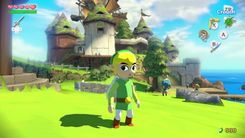
The Legend of Zelda: Wind Waker (Photo: Nintendo)
Common Art Styles in Games
Over the years, numerous game art styles have emerged as development tools and consoles have become more powerful. From the nostalgic charm of pixel art to the immersive realism of 3D graphics, a game's art style plays a crucial role in shaping the player's experience and reflects its themes, story and gameplay.
While some styles aim for lifelike detail, others prioritize creativity and abstraction, offering a unique artistic experience. There are many reasons to choose a particular art style and often, it simply comes down to personal preference.
2D Game Art Styles
Our first category is 2D art styles, which refers to two-dimensional images, such as flat shapes or objects. This style has gained popularity in indie, mobile and casual games due to its simplicity and lower development costs.
While you might assume that 2D styles are less popular than 3D, some of the most successful games have embraced the 2D approach, from Ubisoft’s Rayman to indie developer ConcernedApe’s Stardew Valley.
Pixel Art
Pixel art is a digital art style that uses pixels to create blocky, bitmap-based 2D images. The complexity can vary, ranging from hundreds to even thousands of pixels, depending on the level of detail you want to achieve.
In computing, a bitmap (also called raster) graphic is an image formed from rows of different colored pixels.
Pixel art remains a popular style, evoking a nostalgic, retro feeling reminiscent of early arcade games. Modern releases like Undertale and Stardew Valley have seen meteoric success with pixel art.
This style can be incredibly detailed or more simplistic, depending on the direction of your game. It’s also versatile in terms of color schemes, ranging from bright and cozy to darker, horror-inspired palettes. Pixel art is a great choice for developers with limited artistic experience or knowledge of 3D modeling. However, it does come with limitations, such as inflexibility when resizing assets, which may require recreating or extensively modifying artwork.

Stardew Valley (Photo: ConcernedApe)
Flat Art
This art style prioritizes simplicity over realism, with objects typically featuring single blocks of color and lacking the depth or volume seen in more realistic styles.
The assets often resemble paper or cardboard cutouts, yet can still showcase a rich variety of colors despite their limited depth.
Because of its simplicity, flat art frees developers from the constraints of real-world physics and realism, allowing for more creative experimentation with gameplay.
While these styles are minimalistic, clean and easy to render, they can be limiting when trying to achieve realistic visuals.
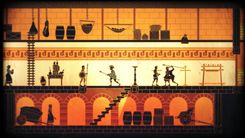
Apotheon (Photo: Steam)
Vector Art Style
Vector art is a more technical style compared to those we've covered so far. It relies on black outlines, simple shapes and flat colors, created using specialized software that constructs assets through mathematical algorithms.
While it may sound similar to pixel art, vector art stands out for its ability to scale and resize without losing detail or sharpness, making it a versatile choice for game development.
However, achieving highly detailed, realistic textures and shading can be challenging, often requiring more creative approaches to reach that level of detail.

Monument Valley (Photo: Steam)
Cutout Art
Cutout art is a playful game style that blurs the lines between traditional and digital art, originally inspired by classical animation techniques.
This style utilizes hand-drawn 2D sprites that mimic being cut from paper. Developers often employ a flipbook animation approach, showcasing one image after another to simulate run cycles or other animations.
With its unique visual experience, several games, such as Paper Mario and Don’t Starve, have achieved great success using this art style. However, it's important to consider its demographic appeal, as it may not resonate with all players when choosing this approach for your game.
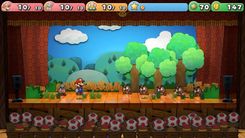
Paper Mario (Photo: Nintendo)
Monochromatic Art
Monochromatic art primarily utilizes a single color, employing various tones, tints and shades to create depth and contrast.
This art style can range from stark black and white to different shades of a single color. The absence of multiple colors is what characterizes the visuals as monochromatic.
Using a limited palette can make a strong visual statement and serves as an effective mode of storytelling through the absence of color.
Video games like Hollow Knight use this approach, showcasing a unique and distinctive art style that uses a simple yet effective color palette to craft a visually captivating world.
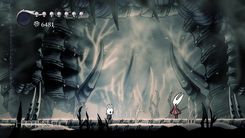
Hollow Knight (Photo: Steam)
3D Game Art Styles
If you're looking to create a more immersive gaming experience, 3D art styles could be the perfect choice for your game. Whether you’re inspired by the realistic art style of Red Dead Redemption 2 or the fantasy realism of The Witcher 3: Wild Hunt, a 3D art style can help your players feel more engaged in your game world.
Low-Poly Art
Low-poly art, shorthand for ‘low polygon art,’ is a more minimalistic and stylized 3D aesthetic that requires fewer resources compared to high-poly art, which features more photorealistic and detailed models.
One of the most well-known games that uses low-poly art is Minecraft. With its blocky, low-poly models and geometric shapes, Minecraft has created a visually appealing and instantly recognizable stylized world.
Originally, low-poly art was favored because it was less resource-intensive and more budget-friendly for development. This style is particularly useful when working within the limitations of less powerful platforms, such as Virtual Reality or mobile devices, which may not support the demands of more detailed graphics.
However, since this art style tries to be as minimalistic as possible, a lot of detail can be lost compared to other art styles.

Minecraft (Photo: Nintendo)
Realistic Art
This 3D art style seeks to capture real-life environments and characters with stunning detail, utilizing high-poly modeling techniques to create photorealistic models and high-resolution textures.
Video games like The Last of Us and Red Dead Redemption 2 have achieved immense success with this realistic art style.
While creating photorealistic games was once a daunting task for small teams, it has become more accessible in recent years thanks to various resources, such as Quixel's Megascans, which provides photo-scanned textures and models for developers.
Although this style creates an immersive, lifelike world, any errors in models or lighting can be glaringly obvious. Maintaining consistent quality across all elements of the game can require significant time and financial investment compared to more stylized art styles.

Red Dead Redemption 2 (Photo: Rockstar Games)
Fantasy Realism
Fantasy realism is an art style that merges fantasy themes and elements with the rendering techniques typical of realistic art styles.
Games like The Witcher 3: Wild Hunt and God of War Ragnarok exemplify how this style combines realistic art methods with imaginative fantasy elements to create stunning, immersive worlds for players.
While much like realistic art styles, this approach can provide an engaging experience, it often demands significant hardware resources to render detailed models and high-resolution textures, which may be challenging for smaller teams to access.
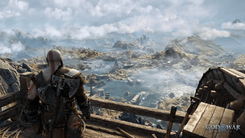
God of War Ragnarok (Photo: Sony Interactive Entertainment)
Cel-Shading Art
Cel-shading blurs the line between 2D and 3D game art styles. It employs 3D assets while utilizing hand-painted textures that mimic the look of comic books and brush strokes.
Often favored for its stylized approach, cel-shading can create a striking visual impact that can help a game stand out in the market. Titles like The Legend of Zelda: The Wind Waker and Borderlands have achieved significant success by using this timeless style.
While cel-shading can effectively help your game stand out, it can appeal to a smaller audience who may prefer more realistic art styles.

Borderlands 3 (Photo: Gearbox Software)
Stylized Art
Stylized art encompasses a broad range of visual looks, prioritizing artistic creativity over technical accuracy. While rooted in realism, it introduces an exaggerated twist designed to appeal to a diverse demographic of players.
In contrast to more realistic games, stylized art often features bright, vibrant colors, exaggerated lighting and character anatomy, helping games stand out in a crowded market.
Stylized video games are typically supported on more consoles than realistic games, which often require more powerful hardware to run. This style also allows developers to express more creativity in creating their own visual language, but if done poorly it can risk looking cheap and gimmicky.
Notable successes in this art style include Fortnite from Epic Games and Overwatch from Blizzard Entertainment, both of which have turned their unique visual languages into recognizable brands.

Fortnite (Photo: Epic Games)
How to Choose the Right Art Style
Now that we’ve explored various art styles you might use for your video game, it’s time to focus on how to select the right one for your project. Here are several key factors to consider:
Know Your Game’s Genre
A game’s genre significantly influences the choice of art style. Some genres lend themselves better to certain styles, so it’s essential to consider what will resonate most with your target audience. For instance, if you're developing an action game, a 3D art style may be more suitable than a 2D one, as it can enhance depth perception and gameplay dynamics.
Budget & Resources
The cost of creating art assets can be a significant portion of your game’s overall development budget. For example, Stardew Valley was developed by a single individual on a shoestring budget, while Sony’s God of War Ragnarok reportedly cost around $200 million to produce.
When planning, you should consider not only your financial constraints but also the development timeline, which can be unpredictable and often extends beyond initial deadlines. The size and skill set of your development team are also critical factors. Whether you’re a solo developer or part of a larger team will affect the type and amount of art you can realistically produce.
Low-poly or pixel art styles are generally more affordable and require fewer resources compared to realistic styles that demand high-quality 3D models. If you’re working with a smaller team, opting for simpler styles like Flat Art or Vector Graphics may be more feasible, whereas realistic games usually require more substantial financial backing.
What is the Games Story?
Your art direction plays a crucial role in conveying the game's narrative and evoking the desired emotional responses from players. Elements such as lighting, mood and atmosphere can significantly impact immersion. For example, a horror game with bright, vibrant colors may fail to create the tension and suspense that a darker, grittier palette could provide.
Consider your expertise
Learning to create art can be a lengthy and challenging process. If you have experience with stylized 3D art, it makes sense to choose that style rather than starting from scratch with pixel art, which involves different techniques and constraints.
Final Thoughts
Selecting the right art style is a challenging but essential decision to make early in game development, as it directly influences gameplay mechanics and player experience. Whether you aspire to create a cozy pixel art game like Stardew Valley or the extreme realism of titles like Red Dead Redemption 2, your choice should balance visual appeal, game genre, target audience and budget.
With this knowledge of different game art styles, you’re now ready to choose the one that will make your game truly engaging for your players!
At Athena Productions, we specialize in helping video games develop their visual identity through our talented concept art team. If you’re seeking reliable and experienced concept artists, get in touch to see how we can help you realize your vision!


